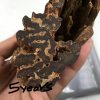The challenge as a person on the sidelines is figuring out what / who to believe in the absence of adequate first hand experience.
it is true dear, but that's why I have made this effort and posts to explain it and educate people about it. it is simple
if anyone say I have or selling "kianm"
simply say where is your lab test
(check it make sure its' from a decent official lab, certified and signed by a professional technician and authenticated by a botanist or chemist) this will eliminate 99% of the noise about the subject, finally get some authentic small piece of kinam from a respected and well-known house or company smell it and experience the profile of it this way you will have the on hand experience and the actual scientific proof.
it's not that confusing even though some may intentionally or unintentionally try to make it confusing!
it's really not as hard as people think and just for the sake of the knowledge and educating everyone I will explore and explain the kinds of kinam available in the market now with full details and pictures (which I doubt any other house or company will do) and this should give everyone the final understanding about kinam (now again I know with all do respect some people here or in other places will simply oppose and argue simply for the sake or opposing and argument so I will keep this very short simple and elaborate for those who want to learn and benefit, we are not a kinam farm, or kinam distributor, and I have absolutely no benefit or reason to provide any false information, finally we have been in the this field for over 300 years we have been commissioned, consulted and asked to view, review and assess all kinds of wood specially kinam, we have done multiple studies and lab tests paid thousands of dollars for all different kinds of samples and wood specially kinam and work hand to hand with kinam farmers, collector and experts for decades.
here is the net post coming










